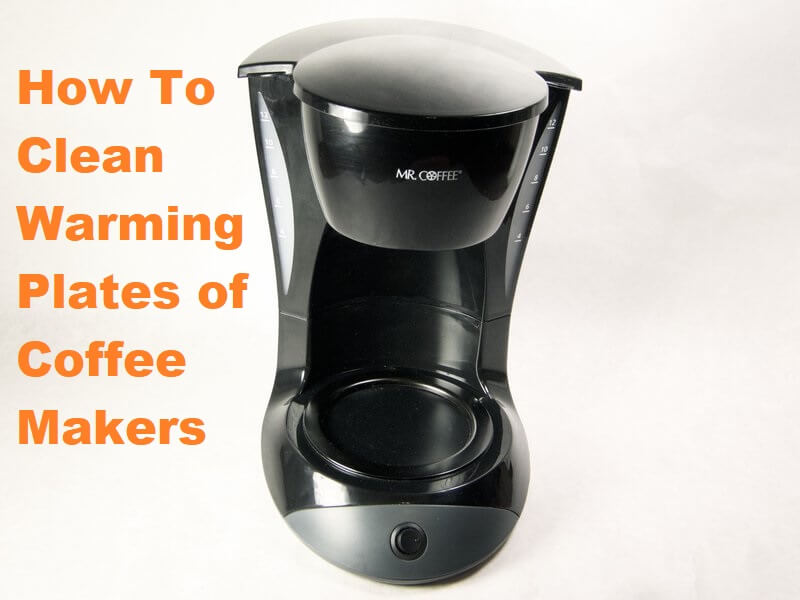A Guide on How to Clean Warming Plate on Coffee Maker?
You use your coffee maker daily, but have you cleaned the warming plate? If not, it’s time to get scrubbing! The warming plate is a heating element in your machine that keeps your coffee warm. It is essential to keep this area clean because bacteria can grow and cause nasty smells over time.
The good news is that cleaning the warming plate on most machines only takes a few minutes and won’t require any special tools or products. To clean it, wipe it down with a damp cloth!

To help you get your coffee maker sparkling clean, we’ve compiled a step-by-step guide that you can follow. First, remove all the visible grounds and other dirt or residue from around and under it with a damp sponge or rag. Rinse everything off thoroughly before moving on to step two:
cleaning out iced water tank using white vinegar followed by running eight cups of warm water through machine’s reservoir (removing filter if applicable). Finish up by wiping down exterior surfaces with cleaner/polished cloths to have better-tasting coffee, as well as having an attractive-looking brewer dispensing drops for your caffeinated elixir of life!
What Is a Coffee Makers Hot Plate?
A hot plate in a coffee maker, also referred to as a warming plate or a heating element ensures that your coffee stays fresh and hot until you consume it. Generally, hot plates heat between 120° and 140°, but some allow you to adjust it.
An electric warming plate can also be an excellent addition to a coffee maker. This product is perfect for people who enjoy starting their morning with a fresh cup of coffee and ending it with a hot cup of coffee in the evening.
Keeping the carafe warm and preventing it from getting cold even if you have had it on for some time prevents the coffee and the carafe from getting out.
Hot Plate Vs. Thermal Carafe
With a drip coffee maker, your coffee will stay hot and warm for longer. Coffee makers are different from coffee machines. Among the differences between their coffee water heating methods and carafes is their type of pot. The Lui team conducts both kinds of carafe handling tests, using a hotplate under a glass carafe or in a thermal carafe. Due to their heavyweight, thermal carafes make pouring harder and can drip coffee.
Compared to thermal carafes, they are more expensive. It can be a challenge to clean a thermal carafe at times. It is common for the coffee temperature to decrease or increase by about 2.5°F over one hour. Thermal carafes lose around 4°F after an hour.
Clean the Brew Basket or Water Reservoir
If you use a drip coffee maker, you should clean the brew basket occasionally at the sink, then rinse it thoroughly with warm, soapy water. The oily residues will be removed, so there will be no bad taste left behind.
It is also essential to clean the reservoir if you have a pod coffee maker with a removable reservoir. Check your owner’s manual for dishwasher usage tips (note that not all models can handle this).
Clean the Hot Plate or Drip Tray
You will be able to keep your coffee warm with a hot plate if your drip coffee maker doesn’t have a thermal carafe. Wipe off any spilled coffee after the hot plate has cooled. A damp sponge and baking soda will help remove burnt-on coffee stains.
Coffee pod makers feature a drip tray that your mug rests on instead of a hot plate. In addition to collecting excess coffee, the drip tray can become a breeding ground for germs. Be sure to wash the tray with warm water and soap every time.
Remove Mineral Deposits
Your coffee maker’s tank and tubes can get clogged with minerals in your water.
Eventually, excessive steaming and long brew cycles are two telltale signs of trouble. If the problem gets bad enough, the machine could stop working entirely, or its brewing performance will be impaired.
The removal of this mineral buildup is called descaling. If your machine has a cleaning indicator, it will illuminate when it’s time to begin this process.
Finishing the descaling process doesn’t mean you can start brewing coffee right away, however. “Always run the brew cycle with water a couple of times to get rid of the vinegar taste before brewing coffee,” Lui says.
Some machines require unique solutions for cleanup that are not as harsh on your machine’s components or use dedicated cleaning cycles, so check your owner’s manual if there are any specific instructions in it about this particular matter.
Clean the Carafe
The carafe is an essential part of any coffee maker. It can be your saving grace or a hindrance to making great cup after great cup, and it all depends on how well you take care of it. There are two types: glass or insulated thermal?
What does that mean for you? If your machine uses an insulated stainless steel one, then make sure to clean with soap and warm water every time as these types don’t allow heat from boiling water to leak out, which could cause burning yourself in contact with steam during the cleaning process.
But if yours has glass carafes, then here are some tips! After each brewing session, rinse the inside out, so you remove those pesky stains that seem impossible (or at least super difficult)
Easy-to-Clean Coffee Makers
Rather start fresh? Here are four models (two drips and two pods) that perform well in our convenience tests, which evaluate, among other factors, how easy the machine is to clean.
Final Thoughts on Clean Warming Plate on Coffee Maker
To maintain the quality of your coffee, you need to remove rust from your coffee maker’s hot plate. By following the steps above, you will be able to restore your machine to like-new condition in no time.
How Often Should I Clean The Warming Plate Of My Coffee Maker?
A warming plate should ideally be cleaned daily. This will only require a cloth to clean it. If you don’t have the time or you’re too lazy (like me), try the method above once every two months.
Keep in mind that it all depends on how often you use your coffee maker. If you are making several pots of coffee each day, you should consider cleaning your machine more frequently.
What Can You Use Besides Vinegar To Clean The Warming Plate of Coffee Maker?
You could use other products in place of vinegar if you do not have it at home or do not like its smell.
Note: Clean a coffee maker gently without using harsh or corrosive cleaners.






